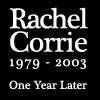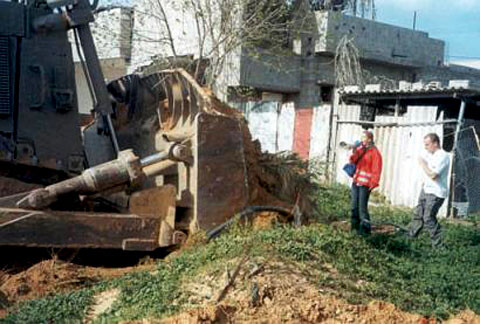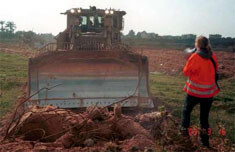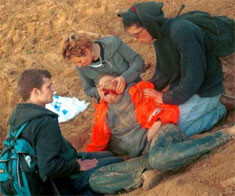The Electronic Intifada 19 March 2004

Now I don’t know, but I been told
If the horse don’t pull you got to carry the load.
I don’t know whose back’s that strong, maybe find out before too long.
One way or another, One way or another
this darkness got to give.
(Lyrics excerpted from “New Speedway Boogie” recorded on the 1970 album Workingman’s Dead by The Grateful Dead)
In order to understand the meaning and scope of human rights, it is necessary to define what it is to be human. According to the discipline of anthropology, human beings are characterized by bi-pedal locomotion (the ability to walk on two feet and to stand upright), stereoscopic vision, an opposable thumb enabling tool-use and innovation, and the ability to create, learn, and modify socially shared symbol systems in order to communicate, persuade, and cooperate in the here and now as well as to recall the past, prepare for the future, or imagine situations and states other than those we are currently experiencing. Physically as well as mentally, human beings can adopt many different positions and adapt to a wide variety of situations and environments.
Having a perspective and taking a stand are not just figures of speech for human beings, but are in fact basic to, and implicit in, being human. To be human means to be in relationship: to others, to places, to spaces and things. Human beings demonstrate a profoundly dynamic engagement with space, whether natural or social. Actively shaping and questioning the terms of such relationships is what most of human history has been all about. As human beings, we have a choice. We can fight or flee, create or destroy, nurture or kill, be active or apathetic. Depending on perspective and stance, humans can hope just as avidly as they can despair.
Our unique posture is heralded by the very name of the science that studies all aspects of being human in space and time: “anthropos” is Greek for “he who looks up.” It takes a backbone to do that — literally and figuratively.
Standing up, standing for, standing in

Picture taken between 3:00-4:00PM, 16 March 2003, Rafah, Occupied Gaza. Rachel Corrie (L) and Nick (R) oppose the potential destruction of this home (to the west of the Doctor’s home where Rachel was killed). In the instance pictured, the bulldozer did not stop and Rachel was pinned between the scooped earth and the fence behind her. On this occasion, the driver stopped before seriously injuring her. Photo by Joseph Smith (ISM Handout).

Picture taken between 3:00-4:00PM on 16 March 2003, Rafah, Occupied Gaza. A clearly marked Rachel Corrie, holding a megaphone, confronts the driver of one of two Israeli bulldozers in the area that were attempting to demolish a Palestinian homes. She was confronting the bulldozer in order to disrupt its work, and prevent it from threatening any homes. Photo by Joseph Smith. (ISM Handout)
One photo of Rachel was taken from the front, the other from behind. In both photos, she is standing firmly on both feet, gripping a megaphone, and looking straight ahead with purpose and concern as she attempts to communicate with the unseen driver of an armoured D-9 Caterpillar bulldozer, a surreal merger of man and machine, policy and implement, weapon and vehicle.
From her posture, positioning, and facial expressions, it is obvious that Rachel Corrie wanted to influence the bulldozer operators’ actions, to alter their motivations, and affect their perspectives. In other words, Rachel was being fully human — standing, thinking, communicating, feeling, engaging, and using tools (not weapons), to shape her immediate natural and social environment not only for her own interests, but for the interests of others. She had already put herself in another’s place, demonstrating a uniquely human capacity: empathy.
Rachel assumed that her humanity, coupled with her privileged position as a US citizen standing tall and firm there at the edge of Gaza, was all the armour she needed in this confrontation with the brutal momentum of military occupation. Relying on that armour, along with a firm belief in human rights and international humanitarian law, Rachel and hundreds of other ISM activists had hoped to stand up for Palestinians suffering under Israeli occupation by standing in for the international community, which has consistently failed to live up to its responsibilities, as outlined in the Fourth Geneva Convention, to halt Israel’s systematic and chronic abuses of human rights in the Occupied Palestinian territories. For Rachel and another ISM activist, Tom Hurndall of the UK, who was shot a few weeks later in the same area of the Gaza Strip, the decision to stand up and stand in proved to be fatal.
Although Rachel and her colleagues could not see the drivers of the bulldozers clearly from a distance, it is highly unlikely that they could not see the ISM activists. Rachel Corrie would have been especially hard to miss. A tall and graceful young woman with long blonde hair and the bearing of a dancer, she was wearing, on that last Sunday afternoon of her life, a bright, flourescent orange jacket trimmed with reflecting strips, and she was shouting into a megaphone.
Even as the bulldozer approached, crumpling the earth into a swelling mound of dirt and rocks and lifting her off the ground, Rachel kept standing up and looking forward into the tinted glass window shielding the bulldozer driver from contact with the human being he was about to kill. Rachel slipped under the bulldozer, which then backed up and ran over her.

Picture taken at 4:47PM on 16 March 2003, Rafah, Occupied Gaza. Rachel Corrie lies on the ground fatally injured by the Israeli bulldozer driver. Rachel’s fellow activists have dug her a little out of the sand and are trying to keep her neck straight due to spinal injury. Photo by Joseph Smith. (ISM Handout)
With Rachel’s killing, ISM activsts and all who share their humanitarian goals grounded in universal principles of justice and equality had been put on notice by the Israeli Defence Forces (IDF) that their collective backbone could be broken.
The Bulldozer strikes again, and again….
The IDF bulldozer operators did not know Rachel Corrie. Her killing was professional, not personal. Their aim was not to run over a specific individual, but rather, to crush an entire grassroots movement of support and concern for Palestinians living under a brutal occupation. If a US citizen could be murdered with impunity, then anything was possible and the occupying army’s scope for maneuver would be augmented considerably. Many other representatives of, and attempts at, human rights and international humanitarian law could be more easily bulldozed after Rachel’s unpunished murder.
It is not a coincidence that Israeli Prime Minister Ariel Sharon’s nickname is “The Bulldozer.” The operators of the armoured D-9 Caterpillar bulldozer that killed Rachel are not as responsible for her death as he is. As Israel’s minister of defence, as well as prime minister, Sharon has command responsibility for the daily (indeed, hourly) violations of human rights and breaches of the Fourth Geneva Convention in the West Bank and Gaza Strip. Just as he had command responsibility for the killings of over 1000 Palestinian and Lebanese civilians in the 1982 Sabra and Shatila massacre in Lebanon.

Secretary of Defense Donald H. Rumsfeld. (DoD photo)
The Belgian legislature was not half as brave as Rachel Corrie. Rather than standing firm before Rumsfeld’s bulldozing, they gave in without a fight after ascertaining that their partners in the European Union would not back them up in defending the practice of universal jurisdiction. (1)
Initially the Belgian public had been very proud of their universal jurisdiction, or “anti-atrocity,” legislation. Some critics found it ironic that Belgium, a country once synonymous with atrocities in Central Africa during the reign of King Leopold, should become the venue for the evolution of international justice. But many Belgians were committed to universal jurisdiction precisely because of their country’s bloody colonial history.
Every colonial system is built on bodies, literally or figuratively. Colonialism operates through and thrives upon unequal and imbalanced relationships based on the exploitation, coercion, disenfranchisement, and dehumanization of others. Most colonial systems have provoked resistance, so it is the goal of all serious colonizers to “break the backs” of those who dare to stand up and oppose the grabbing of land, the sucking of resources, the cordoning off of space, the crushing of innocents, and the general daily abuses of human rights occasioned by colonization and occupation. If the natives get restless, they must be reminded of their place. Put back in line. Taught a lesson.
Colonization sets up sharp distinctions, clear boundaries, and uncrossable borders. There is little space left over in the stark divide between colonizer and colonized in which to act in a truly human fashion. But in this limited, suffocating space, conceptions and practices of human rights have managed to gain a foothold, inspiring and mobilizing human beings from all points on the globe. The many accolades that Rachel received after her death underscore the extent to which her spirit was appreciated and the degree to which it inspired others.
Such spirit is necessary, and essential. But it is not sufficient. A skeletal structure is what is most needed for the survival and evolution of human rights in the Middle East.
Anatomy lessons
The vertebral column (also called the backbone, spine, or spinal column) consists of a series of 33 irregularly shaped bones, called vertebrae. These 33 bones are divided into five categories depending on where they are located in the backbone…..In addition to allowing humans to stand upright and maintain their balance, the vertebral column supports the head and arms, while permitting freedom of movement. (2)
Cynics are fond of noting that “international justice is nice on paper, but it lacks teeth.” Teeth are not the problem. What international justice and human rights lack is a back too strong to be broken by tyranny, coercion, bribery, divisiveness, fear, or brutality. As noted above, the human back consists not of a single bone, but rather, a collection of small, irregluarly shaped bones that work together to support a larger structure. Having, and showing, a backbone is a collective effort requiring the participation of all sorts of irregular elements stacked up together to beat the odds.
What human rights and international justice most desperately require in the Middle East is the participation and cooperation of Arabs and Israelis, Christians, Muslims, Druze, and Jews, who are willing to stand up and oppose separation walls, armoured bulldozers, death squads, torture chambers, and the ideological underpinnings of discrimination and dehumanization.
Recently, a delegation sent by the Arab League traveled to Iraq to listen to Iraqis’ views of regional political realities nearly one year after the US/UK invasion. A common sentiment expressed by Iraqis of all backgrounds and classes was “Where were you when Saddam was murdering us?” The august members of the delegation had no acceptable answer.
Official Arab voices offered little or no support to the survivors of the Sabra and Shatila massacre as they attempted to pursue justice in Belgium from 2001-2003. Too few Jewish voices, in Israel or abroad, have been heard protesting the increasingly nightmarish situation in the West Bank and Gaza, where malnutrition levels, according to a recent UN survey, are approaching those of sub-Saharan Africa while a towering wall is closing in on more and more communities and unarmed civilians are subject at any hour to sudden death by snipers’ fire, tank rounds, and Apache attack helicopters.
There are few if any official Palestinian voices left to protest or oppose Israeli abuses or to decry the criminality of suicide bombings of civilian targets in Israel. The Palestinian people’s spine is collapsing, but worse, they lack a head: where is the leadership that is so urgently needed right now?
Just as the human vertebral column, which enables us to stand up and look forward, is comprised of different segments, the international campaign for human rights and justice is also comprised of different segments. When any are missing, the spinal column collapses. One segment cannot do the job of the others, but each segment has to support the others.
The struggle against ongoing human rights abuses and grave breaches of the Fourth Geneva Convention in the Middle East is a weighty but urgent task demanding intensive efforts. It desperately requires the participation of various groups from withing the region itself. Americans and Britons like Rachel and Tom cannot bear this burden alone, however much their respective governments are implicated in the long history of Israeli-Palestinian suffering and Western colonization of the region.
Whose back is that strong? No one’s, individually. Everyone’s collectively. All of us — Americans, Europeans, Africans, Arabs, Israelis, Turks, Kurds, and Iranians — have to work together as humans to end policies of dehumanization, be they practiced in the East or the West, the North or the South. To quote the late Rachel Corrie, who wrote in an email to her mother in February 2003:
“I am just beginning to learn, from what I expect to be a very intense tutelage, about the ability of people to organize against all odds, and to resist against all odds.”
Rachel did not live long enough to put the lessons she learned into practise. It remains for us to shoulder that burden by being as fully human as she was.
Notes
(1) See “2003: A year of US and Israeli defiance of International Law,” Laurie King-Irani, The Electronic Intifada, 2 January 2004 electronicIntifada.net/v2/article2321.shtml for more details.
(2) Van De Graaff, Kent M. Human Anatomy 5th Edition. WEB McGraw-Hill. Boston, MA. 1998.
Related Links
Laurie King-Irani, a co-founder of Electronic Intifada, teaches anthropology in Victoria, British Columbia. She served as North American coordinator of the International Campaign for Justice for the Victims of Sabra and Shatila.




